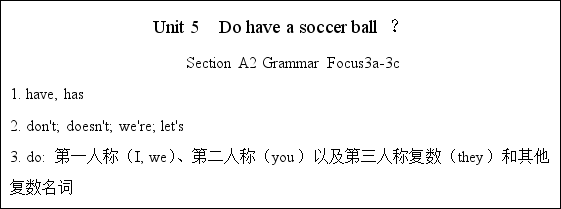

人教新目标 (Go for it) 版七年级上册Section A教案
展开Unit 5 Do have a soccer ball ?
Section A (Grammar Focus3a-3c)
教材:人民教育出版社 七年级上册
一、教学目标:
1. 知识目标:
1) 进一步学习通过运用have对物品的所属进行提问以及应答。
2)继续学会do和does引导的一般疑问句,理解并掌握英语句子中的人称和数
2.能力目标:(掌握并熟练运用下列句型。)
① —Do you have a baseball? —Yes, I do. No, I don't.
② —Does she/he have a tennis ball? —Yes, she/he does. No, she/he doesn't.
③ —Do they have a soccer ball? —Yes, they do./ No, they don't.
3) 能用Let’s…句型来提建议。
3. 情感态度价值观目标:
利用学生喜爱运动的心理,激发学生学习英语的欲望和兴趣,使他们乐于参与各种英语实践活动。在小组活动中,培养学生团结协作精神。
二、教学重难点
1. 教学重点:
1) 总结do和does引导的一般疑问句及其回答语。
2) 在实际生活情景中能正确运用所学的句型谈论自己或他人所拥有的东西。
3) 理解并掌握英语句子中的人称与数,让学生牢记第三人称单数。
2. 教学难点:
1)在实际生活情景中能正确运用Do…?或Does…?句型谈论自己或他人所拥有的东西。
2) 理解并掌握英语句子中的人称与数,让学生牢记第三人称单数。
三、教学过程
Ⅰ. Warming- up and revision
1. Greeting the Ss. Check their homework. (Let some Ss report their parents' sports collection)
S1: My father has a basketball and a soccer ball. My mother has a ping-pong bat and three ping-pong ball.
S2: My father has two volleyballs, three soccer balls and five baseballs. My mother has a tennis ball and a tennis bat.
(Is some Ss make mistakes, correct their mistakes)
2. Let the Ss work in groups (each group has three Ss). Review the sentence structures we learned.
S1: Do you have a basketball?
S2: Yes, I do.
S1: Does she have a basketball?
S3: Yes, she does.
S1: Do you have a tennis bat?
S3: No, I don't.
S1: Does he have a tennis bat?
S2: No, he doesn't.
…
Ⅱ. Grammar Focus.
1. 阅读指导:
1)have意为“有”,表示某人所有某物。have在句子中有两种形式,即have和has。have用于第一人称(I, we)、第二人称(you)以及第三人称复数(they)和其他复数名词;而has则用于第三人称单数(he, she, it)和单数名词。如:
I have an apple. 我有一个苹果。 Mary has an orange. 玛丽有一桔子。
2)have/has句子的一般疑问句是在句首加助动词do或does,句尾用问号构成。除第三人称单数前用does外,其他都用do。第三人称单数前加does后,句中的谓语动词has应改为have。作简略回答时,肯定回答为:“Yes, 主语 + do/does.”,否定回答为:“No, 主语 + don’t/doesn’t.”。
2. Read Grammar Focus and finish off these sentences.
① 你有一个棒球吗?____ you _____ a baseball?
② 是的。___, I ____. 不,没有。_____, I ______.
③ 你有一个乒乓拍吗? ____ you _____ a ping-pong _____?
④ 没有。我有一个乒乓球。_____, I ______. I _____ a ping-pong _______.
⑤ 她有一个网球吗? ____ she _____ a tennis?
⑥ 是,她有。没有。她有一个棒球。
_____, she _________. ____, she ________. She ____ a ______.
⑦ 他有一个足球吗?_____ he _____ a _____ ball?
⑧ 没有。他有两个乒乓球拍。 ____, he ________. He ____ two ping-pong ______.
⑨ 他们有一个篮球吗?___ they _____ a basketball?
⑩ 是的,有。没有。他们有一个排球。
Yes, _____ _____. ____, they ______. They ______ a ________.
3. 写出下列表达方式的缩写形式
① do not = ________ ② does not = ______
③ we are = ______ ④ let us = ________.
Ⅲ. Writing
1. 指导:英语句子中的人称和数
| 人称 | 汉语 | 主格 | 助动词 | 宾格 |
单 数 | 第一人称 | 我 | I | do | me |
第二人称 | 你 | you | you | ||
第三人称 | 他, Eric等 | he |
does | him | |
她, Linda等 | she | her | |||
它 | it | it | |||
复 数 | 第一人称 | 我们 | we |
do
| us |
第二人称 | 你们 | you | you | ||
第三人称 | 他们, 她们,它们 | they | them |
2. Ss discuss with their partner and fill in the chart.
3. Check the answer.
Ⅴ. Practice
1. 指导:实义动词的一般疑问句结构。
① 当主语是第一人称/第二人称/第三人称复数时, 句型结构为:Do +
you/they/we/… + 动词原形 + …? 不管用什么动词,它的回答是固定的。
肯定回答:Yes, I/they /we … do.
否定回答:No, I /they/we … don’t.
② 当主语是第三人称单数时(she, he, it, Linda, Bob及名词的单数形式an apple), 句型结构为:Does + she/he/it/…+ 动词原形 + … ? 不管用什么动词,它的回答是固定的。
肯定回答:Yes, she/he/it … does.
否定回答:No, she/he/it … doesn’t.
2. Note:
① play + 球类 意为“玩、打……”play soccer, play volleyball, play basketball, play ping-pong
② That sounds good. 那听起来不错。 sound 连系动词,“听起来”,后跟形容词。
That sounds great. 那听起来很棒。
3. Ss complete the conversations with their partner.
4. Check the answers with the class. (Let some pairs read the conversation)
4. Ss practice the conversation with their partner then act out the dialogue.
Ⅵ. Game (Remembering game)
1. T: Look! This is Bob's room. He has many things. Look at the things in his room for three minutes. Then close your books and ask and answer questions with your partner.
2. Model:
S1: Does he have a soccer ball?
S2: Yes, he does.
S1: Does he have a computer game?
S2: Yes, he does.
S1: No, he doesn't. You're wrong.
(Then S2 ask S1)
S2: Does he have a volleyball?
S1: Yes, he does. …
Homework
1. Review the Grammar Focus.
2. Complete the conversation after class.
Mike: Hi, Tony. Let’s ______ ping-pong!
Tony: ______ sounds good, Mike.
Mike: Do you ______ a ping-pong ______?
Tony: Oh, no, I don’t.
Mike: ______ your sister have one?
Tony: Yes, she does. Hi, Gina! Where ______ your ping-pong bat?
Gina: It’s _____ the desk.
Tony: OK! _____ go and play!
板书设计

教学反思
人教新目标 (Go for it) 版七年级上册Section A教学设计及反思: 这是一份人教新目标 (Go for it) 版七年级上册Section A教学设计及反思,共4页。
人教新目标 (Go for it) 版七年级上册Unit 1 My name’s Gina.Section A教学设计: 这是一份人教新目标 (Go for it) 版七年级上册Unit 1 My name’s Gina.Section A教学设计,共4页。
人教新目标 (Go for it) 版七年级上册Section A教案设计: 这是一份人教新目标 (Go for it) 版七年级上册Section A教案设计,共6页。















